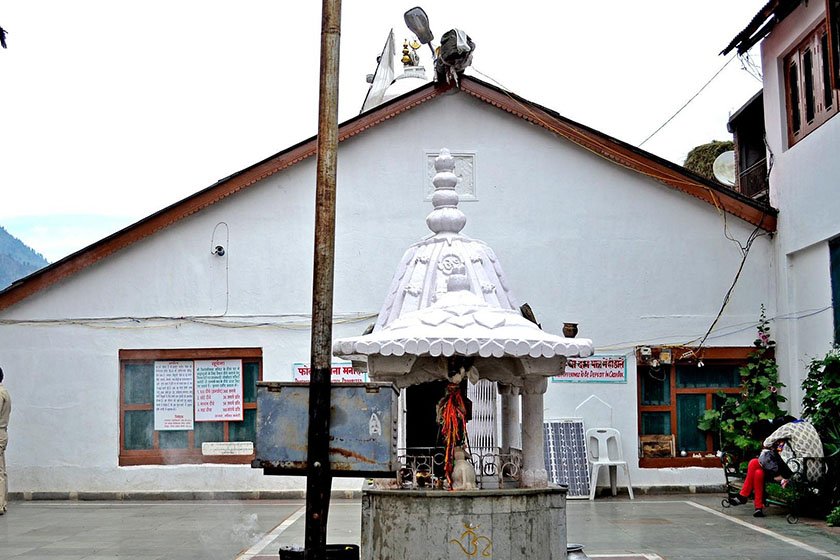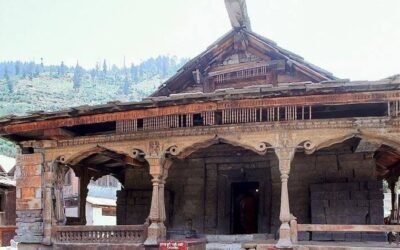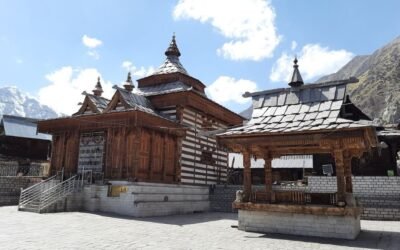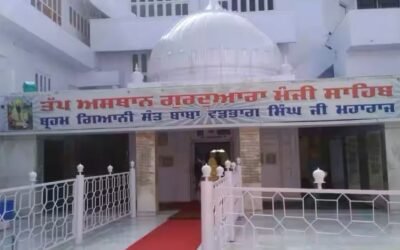Perched at 2,760 meters in the serene Trilokinath village, just 9 km from Udaipur in Lahaul, the Trilokinath Temple is a rare and sacred confluence of Hindu and Buddhist devotion. Revered by Hindus as Lord Shiva and by Buddhists as Arya Avalokiteshvara, this 10th-century shrine is one of the most spiritually significant sites in the western Himalayas, second only to Mount Kailash and Mansarovar in sanctity.
🌄 Location & Accessibility
- Location: Trilokinath village, near Udaipur, Lahaul & Spiti district, Himachal Pradesh
- Altitude: 2,760 meters above sea level
- Nearest Town: Udaipur (9 km), Keylong (45 km), Manali (146 km)
- How to Reach:
- By Road: Accessible via Manali–Keylong–Udaipur route (open May–October)
- By Air: Bhuntar Airport (Kullu) or Gaggal Airport (Kangra)
- By Rail: Nearest station – Joginder Nagar or Pathankot
- Trek Option: From Chuling or Kishori village via the historic Khishori Bridge
🛕 Historical & Mythological Significance
Originally known as Tunda Vihar, the temple was built in the 9th–10th century by Dvanjra Rana, with support from King Shell Varman of Chamba. It was constructed in Shikhara style, similar to the Laxmi Narayan temples of Chamba.
- Hindus worship the deity as Trilokinath (Lord of the Three Worlds), a form of Shiva
- Buddhists revere the same deity as Avalokiteshvara, the Bodhisattva of Compassion
- The idol is made of white marble, seated in lalitasana, with a small Buddha image atop the head
- A local legend tells of a cowherd boy who captured a divine being, who then transformed into the marble idol now enshrined in the temple
🕉️ Deity & Worship
The Trilokinath Temple is uniquely revered by both Hindus and Buddhists, making it one of the few truly syncretic shrines in the Himalayas. Hindus worship the deity as Lord Shiva – Trilokinath, “Lord of the Three Worlds,” while Buddhists venerate the same figure as Arya Avalokiteshvara, the Bodhisattva of Compassion. In Tibetan, he is known as Garja Fagspa.
The sanctum houses a white marble idol seated in lalitasana (royal ease), with a small Buddha image atop the head, symbolizing the fusion of Shaivite and Mahayana traditions. Worship practices include offering butter lamps, white scarves (khatas), red cloth, and incense, with both Hindu priests and Buddhist lamas participating in rituals.
During the Pauri Festival, the deity is honored with processions, ritual bathing in Saptdhara springs, and chanting of both Shiva mantras and the Avalokiteshvara mantra “Om Mani Padme Hum.” Devotees seek blessings for compassion, protection, and liberation from suffering, making this temple a rare confluence of bhakti and bodhicitta.
🏛️ Temple Highlights
- A pagoda-style wooden structure with Tibetan prayer flags and Buddhist wheels
- Shiva lingam and Nandi in the courtyard, alongside Buddhist stupas and prayer wheels
- A silver idol of Mahishasuramardini installed in 1959
- The temple is maintained by a joint Hindu-Buddhist committee, reflecting its dual heritage
🎉 Festivals & Rituals
- Pauri Festival (August):
- A grand three-day fair with processions, folk dances, and ritual bathing in Saptdhara (seven springs)
- The Thakur of Trilokinath leads a horse procession to the springs, believed to be the origin of seven deities
- Devotees chant “Om Mani Padme Hum” and perform parikrama of the temple
- Mahashivratri, Halda, Fagli, and Baisakhi are also celebrated with local customs
- Ghee lamps burn continuously inside the temple, symbolizing eternal light
🏞️ Nearby Attractions
- Mrikula Devi Temple, Udaipur: A wooden marvel dedicated to Goddess Kali
- Tandi Sangam: Confluence of Chandra and Bhaga rivers
- Sissu & Keylong: Scenic villages with waterfalls and monasteries
- Kugti Pass & Miyar Valley: For trekkers and spiritual seekers alike
🙏 Spiritual Experience
The Trilokinath Temple is not just a shrine—it’s a bridge between worlds, where Shaivite stillness meets Buddhist compassion. As you spin the prayer wheels and bow before the marble deity, you feel the rare harmony of two great traditions breathing through the Himalayan air.




